مروری بر تولید نانوذرات با استفاده از میکروارگانیسم ها
مروری بر تولید نانوذرات با استفاده از میکروارگانیسم ها
میکروارگانیسمها برای سوختوساز و انجام فرایندهای حیاتی خود از منابع آلی و معدنی موجود محیط تغذیه میکنند. این ارگانیسمها طی فرایندهای متفاوت، هنگامی که در معرض یونهای فلزی قرار میگیرند، آنها را در در ون یا بر روی دیواره سلولی خود انباشته میکنند. این انباشتگی اغلب منجربه تولید ذراتی است که در اندازههای نانوذرات دستهبندی میشوند. دستیابی به نانومواد قدم ابتدایی در توسعه فناوری نانو است. توسعه روشهای سنتز نانومواد برای تولید موادی با ترکیب و اندازه معین و توزیع مناسب اندازه دانه، از محورهای مورد بحث در پژوهشهای سالیان اخیر محسوب میشود. در این میان روشهای مبتنی بر فناوری زیستی به دلیل تمیز بودن بسیار زیاد و سازگاری بالا محیط زیست از جایگاه ویژهای برخوردار است. این مقاله سعی در بررسی اجمالی این روش ها دارد.
این مقاله شامل سرفصلهای زیر است:
۱. مقدمه
۲. استفاده ازباکتریها در تولید نانومواد
3. استفاده از مخمرها در تولید نانومواد
4. استفاده از قارچها در تولید نانومواد
خلاصه
این مقاله شامل سرفصلهای زیر است:
۱. مقدمه
۲. استفاده ازباکتریها در تولید نانومواد
3. استفاده از مخمرها در تولید نانومواد
4. استفاده از قارچها در تولید نانومواد
خلاصه
لطفا برای مشاهده متن کامل مقاله ابتدا وارد سایت شوید
منابـــع و مراجــــع
۱ - . H. S. Nalwa, “Handbook of nanostructured MaterialsNanotechnology”, Vol. 1 (SynthesisProcessing) , Academic Press, San Diego, 2000.
۲ - www. wikipedia. org, April 2007.
۳ - Deendayal Mandal, M. E. Bolander, D. Mukhopadhyay, Gobinda SarkarPriyabrata Mukherjee, “The use of microorganisms for the formation of metal nanoparticlestheir application”, Applied MicrobiologyBiotechnology, November 2005.
۴ - Nelson Duran, Priscyla D Marcato, Oswaldo L Alves, Gabriel IH De Souza,Elisa Esposito,” Mechanistic aspects of biosynthesis of silver nanoparticles by several Fusarium oxysporum strains”, Journal of Nanobiotechnology, Volume 3, August, 2005.
۵ - Maggy F. Lengke, Michael E. Fleet,Gordon Southam,” Morphology of Gold Nanoparticles Synthesized by Filamentous Cyanobacteria Gold (I) –ThiosulfateGold (III) -Chloride Complexes”, Langmuir, 2006, 22, 2780-2787.
۶ - Konishi Y, Nomura T, Tsukiyama T, Saitoh N, “Microbial preparation of gold nanoparticles by anaerobic bacterium”, Trans Mater Res Soc Jpn 29,2004,pp. 2341–2343.
۷ - Kazem Kashefi, Jason M. Tor, Kelly P. Nevin,Derek R. Lovely,” Reductive Precipitation of Gold by Dissimilatory Fe (III) -Reducing BacteriaArchaea”, AppliedEnvironmental Micrology, July 2001, pp. 3275–3279.
۸ - P. D. Marcato, G. I. H. De Souza, O. L. Alves, E. Esposito, N. Duran,” Antibacterial Activity of Silver Nanoparticles Synthesized by FUSARIUM OXYSPORUM STRAIN”, 2nd Mercosur Congress on Chemical Engineering4th Mercosur Congress on Process Systems Engineering.
۹ - A. Ahmad, S. Senapati, M. Islam Khan, Rajiv Kumar,M. Sastry,” Extracellular Biosynthesis of Monodisperse Gold Nanoparticles by a Novel Extremophilic Actinomycete, Thermomonospora sp. “, Langmuir, 2003, 19, pp. 3550-3553.
۱۰ - Michelle Flenniken, Mark Allen,Trevor Douglas,” Microbe Manufacturers of Semiconductors”, Chemistry & Biology, Vol. 11, November, 2004.
۱۱ - Watson JHP, Ellwood DC, Soper AK, Charnock J, “Nanosized strongly-magnetic bacterially-produced iron sulfide materials”, J Magn Magn Mater 203,1999, pp. 69-72.
۱۲ - Hojatollah Vali, Benjamin Weiss, Yi-Liang Li, S. Kelly Sears, Soon Sam Kim, Joseph L. Kirschvink,Chuanlun L. Zhang,” Formation of tabular single-domain magnetite induced by Geobacter metallireducens GS- 15”, PNAS, November, 2004,vol. 101,no. 46, pp. 16121- 16126.
۱۳ - Swades K. Chaudhuri, Joseph G. Lack,John D. Coates, “Biogenic Magnetite Formation through Anaerobic Biooxidation of Fe (II) “, AppliedEnvironmental Microbiology, June 2001, p. 2844 – 2848.
۱۴ - B. Devouard, M. Posfai, Xin Hua, D. A. Bazylinski, R. B. Frankel,P. R. Buseck,” Magnetite magnetotactic bacteria: size distributationstwining, American Mineralogist, Vol. 83, pp. 1387-1398. 1998.
۱۵ - . Kowshik, Meenal; Deshmukh, Neelima; Vogel, Walter; Urban, Joachim; Kulkarni, Sulabha K.; Paknikar, K. M., “Microbial synthesis of semiconductor CdS nanoparticles, their characterization,their use in the fabrication of an ideal diode”, BiotechnologyBioengineering, Vol. 78, No. 5, 58-3588.
۱۶ - Absar Ahmad, Priyabrata Mukherjee, Deendayal Mandal, Satyajyoti Senapati, M. Islam Khan, Rajiv Kumar,and Murali Sastry,” Enzyme Mediated Extracellular Synthesis of CdS Nanoparticles by the Fungus, Fusarium oxysporum”, J. AM. CHEM. SOC. 2002, 124, 12108- 12109.
۱۷ - Priyabrata Mukherjee, Absar Ahmad, Deendayal Mandal, Satyajyoti Senapati, Sudhakar R. Sainkar, Mohammad I. Khan, Renu Parishcha, P. V. Ajaykumar, Mansoor Alam, Rajiv Kumar,and Murali Sastry,” FungusMediated Synthesis of Silver NanoparticlesTheir Immobilization in the Mycelial Matrix: A Novel Biological Approach to Nanoparticle Synthesis”, NANO LETTERS, 2001, Vol. 1, No. 10, 515-519.
۱۸ - Mukherjee P, Senapati S, Mandal D, Ahmad A, Khan MI, Kumar R, Sastry M “Extracellular synthesis of gold nanoparticles by the fungus Fusarium oxysporum. “ Chembiochem 3, 2002, pp. 461-463.
۱۹ - . S. Shiv Shankar, Absar Ahmad,Murali Sastry,” Geranium Leaf Assisted Biosynthesis of Silver Nanoparticles”, Biotechnol. Prog. 2003, 19, 1627-1631.
۲۰ - S. Shiv Shankar, Akhilesh Rai, Absar Ahmad,Murali Sastry,” Rapid synthesis of Au, Ag,bimetallic Au core–Ag shell nanoparticles using Neem (Azadirachta indica) leaf broth”, Journal of ColloidInterface Science, 275, 2004, pp. 496–502..










فیروز
۱۴۰۱/۰۹/۰۷مدیر سیستم
۱۴۰۱/۰۹/۲۱به روشهای ساختی که منجر به تولید نانومواد میشه، NanoFabrication گفته میشه.